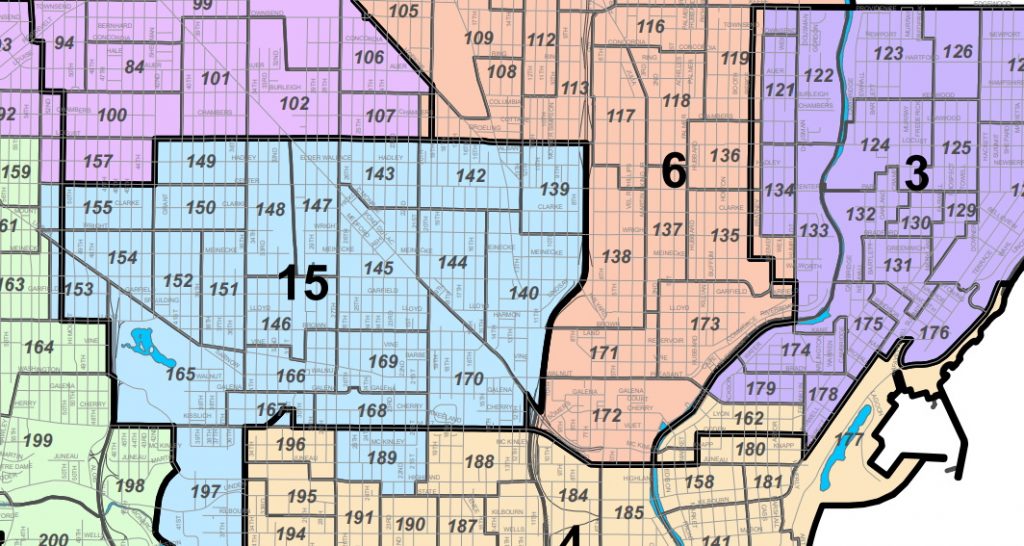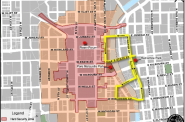Barrett Vetoes Redistricting Map
Voces de la Frontera lobbied for a veto to push council to create third Hispanic district.
The Milwaukee Common Council will need to revisit its proposed district maps.
On Monday, Mayor Tom Barrett vetoed the council’s district map plan and cited concerns with the configuration of a handful of southside districts. Voces de la Frontera requested Barrett veto the map and suggested nine different ways to create a third majority Hispanic district within the decade.
The council adopted the map on Nov. 23 on a 14-1 vote, with only Alderwoman JoCasta Zamarripa in opposition. It must now review the mayor’s veto by its Dec. 14 meeting. The council could override the mayor with 10 votes or adopt a revised map.
The city is now 39.3% Black, 32.3% white, 20.1% Hispanic and 5.6% Asian. When considering only the voting age population, the city is 38.6% white, 36.1% Black, 17.6% Hispanic and 5.1% Asian. The Hispanic population of the city has grown in recent decades while the city’s total population has shrank.
“The growth of Hispanic voting age residents in the existing 13th District reflects that trend, growing from 21.9% in 2012 to 27.1% in 2020,” wrote Barrett. “Milwaukee’s diversity is an undeniable strength, and racial diversity is a critical ingredient in our continued growth and success as a city.”
The council adopted 15 districts that maintain the balance of six Black majority districts, two Hispanic districts and five white districts of which two are being described as Hispanic “influence” districts. There is no legal definition for an “influence” district, but the council is informally defining it as a 25% voting bloc. Two districts have no racial or ethnic majority.
But moving the wards back wouldn’t make the 13th district a Hispanic-majority district. It would however make the 14th district, identified with the Bay View neighborhood, even more white and the 13th district, the Garden District, even more Hispanic.
Of the 2,428 residents in the two wards, 64.8% are Hispanic.
Simply reassigning the wards to the 13th district would trigger a separate issue with the federal Voting Rights Act. The 13th district would become the largest in the city, and more than 13% larger than the least populous district (the 15th on the city’s North Side). The legal threshold is 10%.
The city’s Legislative Reference Bureau, which created the council-approved map, said its map was drawn to comply with the Voting Rights Act and that efforts were also made to keep neighborhoods together by following major streets, rivers and other barriers. The 13th district poses an extra challenge because it is also home to a growing Islamic population.
In separate discussions, Zamarripa and 13th district representative Ald. Scott Spiker both acknowledged the difficulty in creating a third Hispanic-majority district without diluting existing Hispanic-majority districts or drawing irregularly-shaped districts. LRB representatives told the council they attempted to do so, but could not create a map that satisfied their guidelines.
“I urge the Council to consider these [maps] and any other proposals that better reflect Hispanic population growth and assure appropriate representation,” wrote Barrett.
Spiker, during his Nov. 22 committee meeting remarks, suggested that even with doing nothing, the city is likely to see a third Hispanic majority district within the decade.
The influence of the Hispanic vote under any scenario could be further diluted by current disparities in Milwaukee in turnout between Hispanic and white voters.
The new district map will go into effect for the 2024 spring elections for all 15 council seats. Any special election occurring before that time, under state law, would occur with new wards, but under the prior district lines. The election commission would need to accommodate or restrict voters in the new, redrawn wards so that those voting align with those eligible under the prior districts.
The council adopted a new ward map on Nov. 17 which will impact where and with whom residents vote beginning with the Spring 2022 elections. Any new district map also needs to follow the lines set forth by the wards. Barrett signed the ward map into law.
The city’s redistricting, described as a “warp speed” process, was largely out of its control after federal, state and county delays. But in Barrett’s letter, he said the City Attorney’s Office advised him that the council’s adoption of new maps by Jan. 18 “is adequate and will not pose challenges to other jurisdictions, nor interfere with elections.”
“We thank Mayor Barrett for listening to the Latinx community and our appeal that the maps passed by the Common Council be revisited to reflect the growth, movement and importance of the Latinx community on the south side of Milwaukee. We call on the Milwaukee Common Council to not override the veto and to move forward on creating maps with input from leaders in the Latinx community,” said Voces executive director Christine Neumann-Ortiz in a statement.
Maps and Statistics
- Barrett Veto Letter
- Voces-Petering Map Options
- Voces Original Concept Map
- Adopted District Map – Detailed
- Adopted District Map – 11×17
- Adopted District Map Demographics
- Adopted 2021 City Ward Map
- 2012 Ward Map
- 2012 Common Council Districts
- 2000 to 2010 Population Change by Aldermanic District
- 2010 to 2020 Population Change by Aldermanic District
- 2020 Population Change by Wards
- 2020 Aldermanic District Demographics
If you think stories like this are important, become a member of Urban Milwaukee and help support real, independent journalism. Plus you get some cool added benefits.
More about the Milwaukee County redistricting process
- Op Ed: Muslim Community Needs Representation - Janan Najeeb - Jan 29th, 2022
- City Hall: Council Ends Redistricting With Anger, Tears - Jeramey Jannene - Jan 18th, 2022
- Statement from Milwaukee Mayor Cavalier Johnson - Mayor Cavalier Johnson - Jan 18th, 2022
- City Hall: Latino Leaders Could Sue Over Redistricting - Jeramey Jannene - Jan 14th, 2022
- Latinx Leaders Condemn Common Council’s Refusal to Draw New Districts Reflecting Dramatic Growth of Latinx Population; Demand Second Legal Opinion - Voces de la Frontera - Jan 14th, 2022
- Voces de la Frontera Statement on Redistricting Decision - Voces de la Frontera - Jan 11th, 2022
- Statement on redistricting decision - Ald. JoCasta Zamarripa - Jan 10th, 2022
- City Hall: Milwaukee Starts Over On Redistricting, Only To Adopt Same Map Again - Jeramey Jannene - Jan 10th, 2022
- Statement by Milwaukee Mayor Tom Barrett: - Mayor Tom Barrett - Dec 14th, 2021
- City Hall: Council Halts Redistricting After Latino Pushback - Jeramey Jannene - Dec 14th, 2021
Read more about Milwaukee County redistricting process here
Political Contributions Tracker
Displaying political contributions between people mentioned in this story. Learn more.

























The article cites a “growing Islamic population” as an extra challenge to drawing South Side districts.
I thought the Voting Rights Act applied to race, color, or language minority status. How is it that religion enters into the ;picture?
@Mark – Forgive my shorthand description. The community would technically be Arabic or Asian. You are correct that no one is protected by the VRA on the basis of their faith. My bigger picture aim was to illustrate that there are more communities at play in the district than simply white and Hispanic.